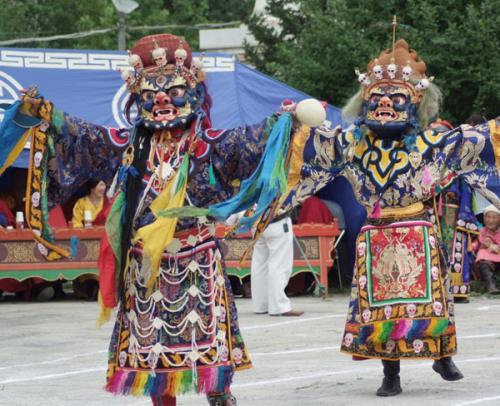 The Zuun Khuree
The Zuun Khuree
Dashchoilin Monastery organized a Khuree Tsam Dance on July 20 to commemorate their
20th anniversary. This was the seventh time the monastery organized such
a program.
About
how tsam came to Mongolia, old records say, “When the Buddhist religion started
to spread in the snowy land of Tibet and the first monasteries and shrines were
founded there, the malevolent guardian spirits of the waters and the lands
hindered and obstructed the spreading of the religion. So the Indian master
Badamjunai, following the secret tantric teachings, organized a tsam dance and
by means of it he tamed and defeated these malevolent spirits and started to
spread the precious Buddhist Teaching. He established the first Tibetan
monastery, the splendid and glorious Samiyaa. From that time the tsam dance began
to spread.” Finally ir became a part of Mongolian Buddhist practices.
Tsam dances are spectacles of sublime
and mesmerizing beauty, of color, motion and sound that serve as public
performances as well as divine offerings. Tsam dancers meditate, pray and
softly chant while performing. Their dancing is
“meditation in action,” creating a sacred space with a
particular felt mood or vibration, and is also an active prayer with a particular
target. Tsam can also be seen as a “shamanic” kind of exorcism or
purification of a given place or time – or better, a Buddhist
“blessing” or energizing-event designed to uplift and make virtuous
the audience”s mind. Tsam dancers are seen to embody or “channel” the
Divine beings – their created space is that of a Deity”s presence in its own
transcendent palace and grounds.
Khuree
tsam is bigger, more elaborate in terms of masks, ornaments and handicrafts,
rituals and content was more extensive compared to other types of tsam and some
researchers concluded that Mongolian tsam was the most “precious” in
the world. This distinction is directly connected with the Buddhist scholars
and masters of Mongolia and also cultures of certain regions and people. Khuree
tsam was performed between 1811-1937 without interruption and during great
repression thar took place in Mongolia, it was destroyed like other Buddhist
rituals. From 1990-s, democracy was introduced in Mongolia and there was a
campaign to revive Mongolian tradition and culture, as a result activities of
restoring some ancient temples and forgotten rituals were initiated. There is a
great demand for time and funding to revive Buddhist rituals interrupted for
over 70 years, and most of all there is a lack of monks who has knowledge to
perform those rituals. Nowadays, there is no obstacle from the side of the
state and society and there have been a number of tsam performances in the
frame of religious ritual and it is important to organize the events in more
expanded forms.
 3,575.44
3,575.44







